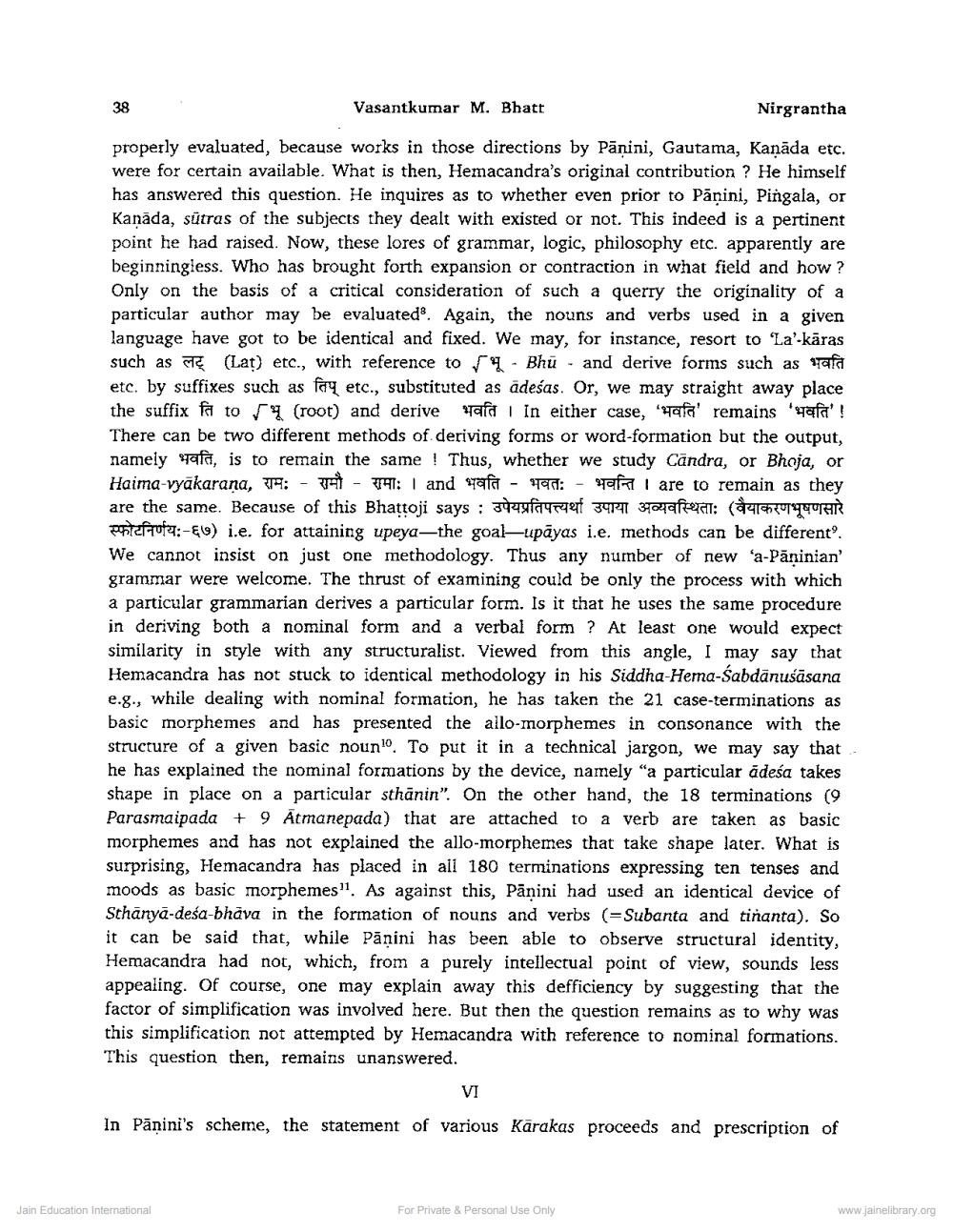Book Title: Kalikal Sarvagna Acharya Hemchandra A Re Appraisal Author(s): Vasant M Bhatt Publisher: Z_Nirgrantha_1_022701.pdf and Nirgrantha_2_022702.pdf and Nirgrantha_3_022703.pdf View full book textPage 4
________________ 38 Vasantkumar M. Bhatt Nirgrantha properly evaluated, because works in those directions by Pāṇini, Gautama, Kanāda etc. were for certain available. What is then, Hemacandra's original contribution ? He himself has answered this question. He inquires as to whether even prior to Pāṇini, Pingala, or Kanāda, sutras of the subjects they dealt with existed or not. This indeed is a pertinent point he had raised. Now, these lores of grammar, logic, philosophy etc. apparently are beginningless. Who has brought forth expansion or contraction in what field and how ? Only on the basis of a critical consideration of such a querry the originality of a particular author may be evaluated. Again, the nouns and verbs used in a given language have got to be identical and fixed. We may, for instance, resort to 'La'-kāras such as tę (Lat) etc., with reference to 4 - Bhu - and derive forms such as safa etc. by suffixes such as fry etc., substituted as adeśas. Or, we may straight away place the suffix ति to भू (root) and derive भवति । In either case, ‘भवति' remains 'भवति' ! There can be two different methods of deriving forms or word-formation but the output, namely safa, is to remain the same ! Thus, whether we study Candra, or Bhoja, or Haima-vyakarana, 7-:- 14 - 11:and watch - G: - Tefal are to remain as they are the same. Because of this Bhattoji says : 344furter 34P 39c4afea: (416h01TUAR poteffa-EV) i.e. for attaining upeya—the goal-upāyas i.e. methods can be different We cannot insist on just one methodology. Thus any number of new fa-Pāṇinian' grammar were welcome. The thrust of examining could be only the process with which a particular grammarian derives a particular form. Is it that he uses the same procedure in deriving both a nominal form and a verbal form ? At least one would expect similarity in style with any structuralist. Viewed from this angle, I may say that Hemacandra has not stuck to identical methodology in his Siddha-Hema-Sabdānuśāsana e.g., while dealing with nominal formation, he has taken the 21 case-terminations as basic morphemes and has presented the allo-morphemes in consonance with the structure of a given basic nouno. To put it in a technical jargon, we may say that he has explained the nominal formations by the device, namely "a particular adeśa takes shape in place on a particular sthānin". On the other hand, the 18 terminations (9 Parasmaipada + 9 Atmanepada) that are attached to a verb are taken as basic morphemes and has not explained the allo-morphemes that take shape later. What is surprising, Hemacandra has placed in all 180 terminations expressing ten tenses and moods as basic morphemes". As against this, Pānini had used an identical device of Sthanya-deśa-bhāva in the formation of nouns and verbs (=Subanta and tiñanta). So it can be said that, while Pāņini has been able to observe structural identity, Hemacandra had not, which, from a purely intellectual point of view, sounds less appealing. Of course, one may explain away this defficiency by suggesting that the factor of simplification was involved here. But then the question remains as to why was this simplification not attempted by Hemacandra with reference to nominal formations. This question then, remains unanswered. VI In Pāṇini's scheme, the statement of various Kārakas proceeds and prescription of Jain Education International For Private & Personal Use Only www.jainelibrary.orgPage Navigation
1 2 3 4 5 6 7 8
